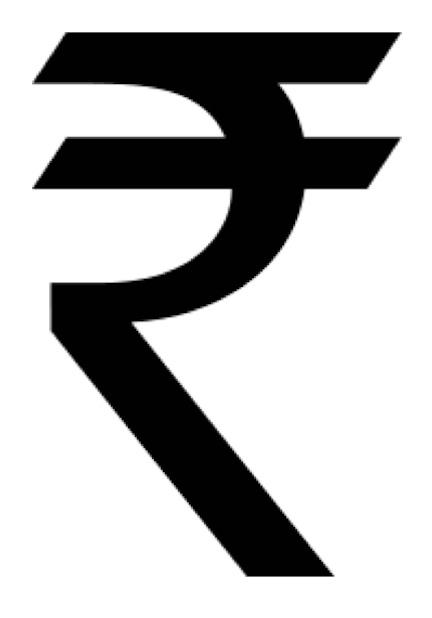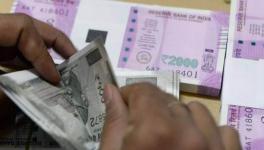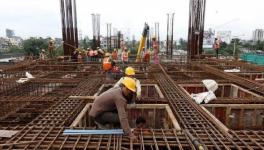The Falling Indian Rupee
The Indian rupee is falling. In a discussion with Newsclick, Jayati Ghosh, Professor at the Centre for Economic Studies and Planning, JNU, points out extreme current account deficits and trade deficits as major reasons for the decline in the Rupee. She suggests that cutting down on non-essential imports such as gold, and instituting strong tariff structures. The present Indian economy shows all symptoms of a pre-crisis; the house of cards has been set, but the impact from the fall cannot be gauged yet.

Prabir Purkayastha (PP) : Hello and welcome to Newsclick. Today we have with us Prof. Jayati Ghosh from Jawaharlal Nehru University, Department of Economics, to discuss the sliding of the rupee. The rupee seems to have come to its lowest point for quite some time. Is it something which is systemic in the Indian economy at the moment, that the external account deficits are really rising and therefore this is whats happening or is it something which is temporary because of certain FII decisions to withdraw some money and so on
Jayati Ghosh (JG): No, I think FII decisions to withdraw are part of a recognition of a wider weakness. And this is part of this has been evident for sometime. It had to come, its coming now perhaps because of the fact that globally also there is more uncertainty, and there is a slight shift back to the United States, but clearly India, even among the emerging markets and among the other BRICS is seen as possibly the weakest economy at the moment.
PP: So therefore you think this is part of a longer difficulty in Indian economy
JG: I would say it is a medium term problem and a problem that has been building up for sometime. We have a very very large current account deficit and we have an extremely enormous trade deficit which has been rising rapidly in the last two years. Some of this could have been contained, for example, a large part of it is gold imports for which there is really no justification. So the government should have acted a lot earlier, to stem the gold imports. Some of it is because of the price of oil, thats what the government keeps saying, but you know, its really because we have also mismanaged the oil economy to a significant extent as you know. So a large part of it is, the fact that all these years of domestic mismanagement which have been reflecting in the external account are coming home to roost.
PP: So this is structural problem of Indian economy that is displaying itself in terms of an external account deficit at the moment?
JG: You see we have been running very large deficits. The difference is that in the last 2 years these deficits are growing and they are more and more reliant on very short term inflows which we know are notoriously volatile and we also know this is a pattern that many many countries have gone through that when those deficits reach a certain point, then international capital and your own domestic capital – all get nervous and decide to keep away.
PP: Now, there are 2 parts to the current account deficit. One is the fact that you are importing large amounts and there is a huge trade deficit that is there. And secondly, of course, that you have been inviting the FIIs in a very large way and that actually also inflates your imports. Fact is that they are looking for certain kinds of goods, setting up certain kinds of industry; a lot of it is just hot money.
JG: The FIIs dont necessarily, directly inflate imports. What happens is, we have 3 kinds of capital inflow. One, is we have the FDI, so called, the direct investment. A lot of that, as you say is much more import intensive and it also leads to outflows on the current account which are things like the repatriation of profits, the royalties that you pay, the technical fees, the consultants that they hire from abroad. So these typically they use much more foreign exchange. There is another kind of FDI that we got lot of recently, which is private equity. Now, private equity is not in there for the long term. They come basically to buy up distressed assets, restructure them and sell them off at a profit. So they are inherently short term in nature. We had a lot of that in the last 5 or 6 years. A lot of that would be leaving and of course when they repatriate they are taking capital gains and in between they are taking dividends. Then there is external commercial borrowing. We have absolutely encouraged domestic companies to go in for larger borrowing from abroad because the interest rates are much lower and while India was favoured as a desired destination, many of these companies were able to access cheaper loans. They have taken on loans, often for global expansion. In fact, it is ridiculous that there is lot of borrowing by Indian companies, not for domestic investment, but even for external investment. Some of it from our public sector banks, some of it from external borrowing. But, it ends up showing in our external accounts. Now, in addition to that, we have a significant increase, not just in the trade deficit, but we are losing in some areas that used to be what we assumed we could just keep raking it in forever. For example, remittances. Remittances have saved the balance of payments for the last three decades. But the rate at which they are able to save is coming down. In other words, they are not increasing as fast as they were. So, remittances are becoming a weaker source of strength. They are still a source of strength, but the rate of increase is less. Some of our invisibles, the software surplus is falling. We are importing a lot more software than we were in the past. Even in these areas of supposed strength, we are not as strong as we used to be. And then, of course, the global environment is such that our exports are flat, or falling. If we look at the last financial year, our exports fell, imports fell at a slightly lower rate. So, the gap grew. So, we have this ballooning trade deficit and we have these invisible payments which are less able to meet that trade deficit. So the current account deficit is now 5.7 % of GDP, nearly 6 %, a ridiculously high amount.
PP: Jayati, there are two strategies the government seems to be following. One is to invite more short term money in, more hot money in, making it even more attractive to foreign capital. The other seems to be, cutting down on essentially what it calls, subsidies to the poor. That seems to be its direction in trying to control its deficit. What do you think is the government's response to the existing crisis that we are seeing?
JG: In fact, both of those things that you have mentioned are part of the same idea. It is that you have to attract foreign capital, come what may. Because that is the only way you can finance the deficit. So you are not thinking about closing the deficit, you are not thinking about how can we reduce this deficit in a way that will direct more expenditure domestically; you are saying only foreign capital can save us, what can we do to somehow bring them in, and of course, one of the things you have to do, supposedly to attract foreign capital is to cut down on fiscal deficit, which means you have to cut down on every form of spending which is seen as populist. In other words, it will affect the people and the poor. It doesn't mean that you are not going to keep providing subsidies to large corporates. There is still an attempt to do a gas pricing system that would hand over a huge amount of money just to one company, for example. And that would go from the public exchequer. Nobody talks about the subsidy, nobody talks about the fiscal deficit when you are talking about that kind of thing. But when it comes to essential spending, when it comes to spending which would meet the social and economic rights of the people, suddenly that we can't afford any more.
PP: You can afford subsidy for a money, but you cant afford subsidy to give food to Indian people
JG: That's on part of it and the other is, then you have to make life easier for the foreign capital that comes in, because, somehow you have to attract them. How do you make life easier – you reduce the regulations on them when they are here, you reduce any constraint on them taking the money out, because they are only going to come in if they know that they can take it out easily and you reduce all kinds of things like, tax structures. You bring down the tax elements, you bring down
things like capital gains tax, you provide more areas in which they can invest. This is very clearly what the Manmohan Singh government is planning to do in the near future. A range of things that would liberalise financial institutions, get rid of caps on FDI, even the sectoral caps, in this effort to attract hot money of all kinds.
PP: And also remove whatever taxation measures existed which they were anyway floating. The Vodafone case being the classic example.
JG: Absolutely, there is no question of even differential taxation. Even the level playing field in taxes is not to be allowed.
PP: What are the other options that the government has that it is not taking?
JG: There are any number of measures that could be very easily taken. The first is to cut down on non-essential imports and the most significant of these is of course gold. We are once again the sink of precious metals that Keynes described the Indian economy has and there's really no reason for this. It is supposedly going in for re-export. But, we know that that's not the case because there is a significant trade deficit in gold that we have at the moment. We should massively increase the import duty on gold. And prevent this kind of unnecessary import. That would already bring down the trade deficit by at least 20-30 billion dollars. Because we have this massive import in the last year. There is a whole range of others, where we can institute a variable tariff. We are still within our tariff bindings for a whole range of imported commodities. So we could institute variable tariffs on a range of finished goods, which again are non-essential, which are luxury, you know, I mean, Italian marble for housing, all of that kind of thing. We could easily prevent that kind of non-essential imports. We must reduce our reliance on short-term capital. So there's absolutely no reason to keep having large deficits and saying that the only way we can get out of this is try and have more and more short term capital
PP: And more and more deficit
JG: That is fundamentally flawed because that short term capital also leads to current account outflows, not just trade account but current account outflows as well. So its doubly expensive. It can leave very quickly but even while its there, they will be repatriating dividends and profits and things like that.
PP: Even in the oil economy, for instance, we could look at public transport much more, cut down on private transport, make private transport much more expensive, instead of making cars much more subsidised
JG: In the medium term, there's a huge range of measures that we could take. In terms of actually thinking in a green economy way, which we really haven't. In fact our planning has been remarkably bereft of any ecological or environmental considerations. We are not planning for the future in terms of conserving energy, in terms of urbanisation, in terms of our external account; about how to make the Indian economy less vulnerable, less fragile to global capital flows.
PP: Which, in fact, is not only an issue of current account deficit, but also an issue of energy self-sufficiency
JG: Absolutely. Ultimately these are of course things that will effect the economy and when you have a crisis, we will know how deeply that effects every person, even those who have not benefited from the boom. But these are also issues of a strategic significance. You can't be dependent on energy, on food, and on so many basic essentials and still retain autonomy, still hope to be a great power entering the world stage and doing all that kind of thing.
PP: Jayati, one last word. Do you think Indian economy is going to go down very significantly this year, of the kind of crisis we have seen in Greece and Europe and other places?
JG: Let me put it this way. The Indian economy today shows classic pre-crisis symptoms that have been experienced in many other countries. In South East Asian countries in 1997, in Turkey in 2000, in Argentina, in a number of countries. So certainly we have all the symptoms. When exactly this crisis breaks, how it breaks and what the impact is – obviously they are going to differ. But there's no doubt we have got everything of the one of the symptoms of a crisis.
PP: The crystal ball will indicate the good chance of a short term crisis emerging in the Indian economy.
JG: When that happens, the reasons will be economic, but it is going to be ascribed to politics, to a fear of a hung parliament, political instability or not having reformers in place and all kinds of things like that. The real reasons are economic and they are directly the result of the economic strategy of this government.
PP: Structural factors which are systemic factors, which this government is following and even the earlier NDA government had followed.
JG: Well, yes. The earlier NDA government began it, but it has realy been accelerated by the UPA 2.
pp: Thank you very much, we will come back to you again as we observe what's happening to the rupee and the Indian economy.
JG: I wish I could say its a pleasure to talk about it, but its also depressing.
Get the latest reports & analysis with people's perspective on Protests, movements & deep analytical videos, discussions of the current affairs in your Telegram app. Subscribe to NewsClick's Telegram channel & get Real-Time updates on stories, as they get published on our website.
























